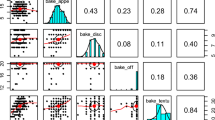Abstract
Forty-four potato cultivars, released in the period between 1876 and the present were grown concurrently in field trials, stored simultaneously in three different environments, then evaluated for chip quality. They represented cultivars historically used and/or bred for potato chip production. Quality factors measured were tuber solids, chip color, reducing sugar levels, sucrose levels, and percent of defect-free chips. Tuber solids tended to increase in the late period cultivars, but trends were erratic. The release of Lenape marked the beginning of an increase in tuber solids that has continued to the present. There was a significant trend for lower reducing sugars and better chip color that corresponded to increasingly later cultivar release dates. Since about 1960, progress toward lower reducing sugars and better chip color has been constant, regardless of whether tubers were stored at 4.4 C, stored at 4.4 C and reconditioned, or stored at 10 C. Late period cultivars tended to have a greater percentage of defect-free chips in comparison to those released earlier, with most of the improvement coming during the last few years. This study provided evidence that potato breeders have made significant progress in developing cultivars with good chip quality. Evidence was also found that Lenape was a landmark cultivar and has been an important contributor to the observed breeding progress
Resumen
Cuarenta y cuatro cultivares de papa liberados entre 1876 y la actualidad fueron plantados al mismo tiempo en ensayos de campo, luego almacenados simultáneamente en tres diferentes ambientes, y posteriormente evaluados para analizar la calidad de las hojuelas. Estos representaron cultivares históricamente empleados y/o mejorados para la elaboración de las hojuelas de papa. Los factores de calidad que se analizaron fueron los sólidos del tubérculo, el color de las hojuelas, los niveles de los azúcares reductores y la sacarosa y el porcentaje de hojuelas libres de defectos. Los sólidos del tubérculo tendían a aumentar en los cultivares de períodos tardíos; sin embargo, las tendencias fueron inconstantes. La liberación de “Lenape” marcó el inicio de un aumento en los sólidos de los tubérculos que ha continuado hasta la actualidad. Hubo una tendencia significativa para azúcares reductores más bajos así como un mejor color de hojuela que correspondió a las fechas progresivamente mas tardías de la liberación de los cultivares. Desde 1960, aproximadamente, el progreso hacia azúcares reductores más bajos y un mejor color de hojuela ha sido constante, a pesar de que los tubérculos fueran almacenados a 4.4 C, almacenados a 4.4 C y reacondicionados, o almacenados a 10 C. Los cultivares de períodos tardíos tendieron a tener un mayor porcentaje de hojuelas libres de defectos en comparación con aquellos cultivares liberados más temprano, y la mayoría del mejoramiento se ha dado en los últimos años. Este estudio proporcionó evidencia de que los mejoradores de papa han obtenido progresos significativos en el desarrollo de cultivares con buena calidad en las hojuelas. También se encontró evidencia de que Lenape fue un cultivar memorable y ha marcado una importante contribution al progreso observado del mejoramiento
Similar content being viewed by others
Abbreviations
- FW:
-
fresh weight
Literature Cited
Akeley, R.V., W.R. Mills, C.E. Cunningham, and J. Watts. 1968. Lenape: a new potato variety high in solids and chipping quality. Am Potato J 45:142–145.
Chase, R. W. 1992. North American potato variety inventory. Potato Association of America, Orono, Maine.
Dale, M.F.B. and G.R. Mackay. 1994. Inheritance of table and processing quality. p. 285–315.In: Bradshaw, J.E. and G.R. Mackay (eds.). Potato genetics. CAB International, Wallingford, UK.
Douches, D.S., D. Maas, K. Jastrzebski, and R.W. Chase. 1996. Assessment of potato breeding progress in the USA over the last century. Crop Science 36:1544–1552.
Gould, W.A. 1980. Quality control procedures for the manufacture of potato chips and snack foods. Potato Chip/Snack Food Association, Alexandria, VA.
Johansen, R.H., J.T. Schulz, and J.E. Huguelet 1969. Norchip: a new early maturing chipping variety with high total solids. Am Potato J 46:254–258.
Miller, J.C., J.F. Fontenot, and W.A. Young. 1963. LaRouge and LaChipper two new potato varieties released by Louisiana. Am Potato J 40:130–132.
National Potato Council. 1995. Potato statistical yearbook. Englewood, Colorado.
O’Keefe, R.B. 1970. Shurchip: a new scab resistant processing potato variety. Am Potato J 47:124–129.
Pavek, J.J. 1987. Some interesting aspects of recent and expected developments in potato breeding in North America. Acta Horticulturae 213:61–65.
Plaisted, R.L. and R.W. Hoopes. 1989. The past record and future prospects for the use of exotic potato germplasm. Am Potato J 66:603–627.
Rieman, G.H. 1962. Superior a new white, medium-maturing, scab-resistant potato variety with high chipping quality. Am Potato J 39:19–28.
Stevenson, F.J., R.V. Akeley, G. Newton, and D. Isleib. 1965. Monona: a new variety of potato, distinctive for excellent chip color after numerous storage treatments. Am Potato J 42:253–255.
Storey, R.M.J. and H.V. Davies. 1992. Pp. 507–569.In: Harris, P.M. (Ed.). The potato crop. Second Edition. Chapman and Hall, New York.
Talburt, W.F. 1975. History of potato processing. p. 1–11.In:Talburt, W.F. and O. Smith (eds.). Potato processing, Third Edition. AVI Publishing Co., Westport, Connecticut.
Thill, C.A. and S.J. Peloquin. 1995. The breeding method for accelerated development of cold chipping clones in potato. Euphytica 84:73–80.
Thompson, N.R. 1967. Potato varieties. p. 43–68.In: Talburt, W.F. and O. Smith (eds.). Potato processing. AVI Publishing Co., Westport, Connecticut.
Vermeer, H. 1990. Optimizing potato breeding. I. The genotypic, environmental and genotype-environment coefficients of variation for tuber yield and other traits in potato (Solanum tuberosum L) under different experimental conditions. Euphytica 49:229–236.
Author information
Authors and Affiliations
Corresponding author
Rights and permissions
About this article
Cite this article
Love, S.L., Pavek, J.J., Thompson-Johns, A. et al. Breeding progress for potato chip quality in North American cultivars. Am. J. Pot Res 75, 27–36 (1998). https://doi.org/10.1007/BF02883514
Received:
Revised:
Accepted:
Issue Date:
DOI: https://doi.org/10.1007/BF02883514




